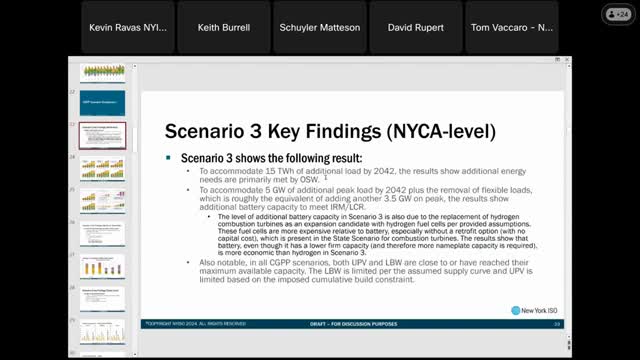Energy Transition Sparks Surge in Battery Capacity and Demand
August 05, 2024 | Department of Public Service, State Agencies, Executive , New York

This article was created by AI summarizing key points discussed. AI makes mistakes, so for full details and context, please refer to the video of the full meeting. Please report any errors so we can fix them. Report an error »

In a recent government meeting, officials discussed significant changes in energy capacity projections, highlighting a projected increase of approximately 8.5 gigawatts in peak load due to shifts in energy consumption patterns and the removal of flexible loads. This adjustment is expected to impact both the Integrated Resource Model (IRM) and Local Capacity Requirements (LCR), necessitating additional resources statewide and particularly in downstate regions.
The meeting revealed that the third scenario in the energy model indicates a substantial increase in battery capacity, primarily driven by the replacement of combustion turbines with fuel cells. While fuel cells are more expensive and lack retrofit options compared to existing units, the analysis suggests that batteries remain the more economical choice despite their lower firm capacity. This shift underscores a broader trend towards renewable energy solutions, as the model anticipates a significant reliance on battery storage to meet future energy demands.
Participants also addressed logistical considerations regarding hydrogen fuel transportation to fuel cell sites. While the model did not specifically account for transportation constraints, it included costs associated with hydrogen procurement, which encompasses both pipeline and vehicle transport methods.
As the meeting progressed, officials presented comparative results from various energy scenarios, emphasizing that the additional demand is largely being met by offshore wind resources. The discussions reflect a critical transition in energy strategy, focusing on sustainable solutions to meet increasing energy needs while navigating the complexities of cost and capacity.
The meeting revealed that the third scenario in the energy model indicates a substantial increase in battery capacity, primarily driven by the replacement of combustion turbines with fuel cells. While fuel cells are more expensive and lack retrofit options compared to existing units, the analysis suggests that batteries remain the more economical choice despite their lower firm capacity. This shift underscores a broader trend towards renewable energy solutions, as the model anticipates a significant reliance on battery storage to meet future energy demands.
Participants also addressed logistical considerations regarding hydrogen fuel transportation to fuel cell sites. While the model did not specifically account for transportation constraints, it included costs associated with hydrogen procurement, which encompasses both pipeline and vehicle transport methods.
As the meeting progressed, officials presented comparative results from various energy scenarios, emphasizing that the additional demand is largely being met by offshore wind resources. The discussions reflect a critical transition in energy strategy, focusing on sustainable solutions to meet increasing energy needs while navigating the complexities of cost and capacity.
View full meeting
This article is based on a recent meeting—watch the full video and explore the complete transcript for deeper insights into the discussion.
View full meeting
